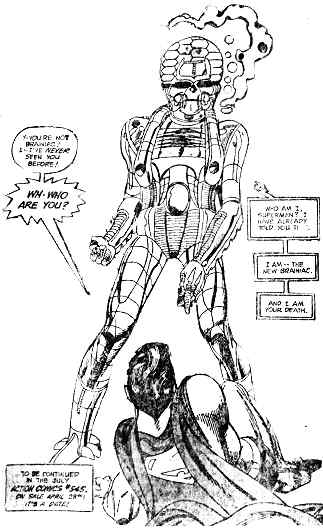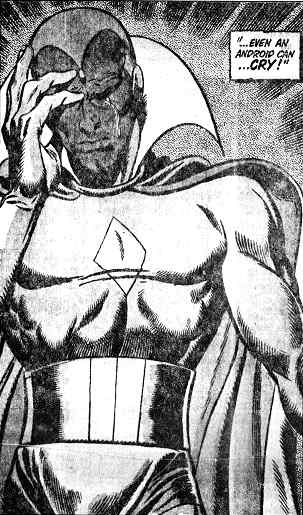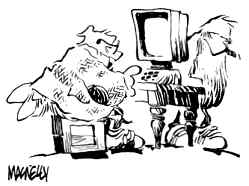COMIC BOOKS
by Steven Grant
Steven Grant writes film and music criticism, novels and comic books, including Howard the Duck and The Life of Pope John Paul II.
 The Superman comic strip introduced three words
to the English language: kryptonite, Bizarro and Brainiac. The first
was a glowing rock, the second a rock-faced parody of the hero, and the
third the first major computer villain of the modern age.
The Superman comic strip introduced three words
to the English language: kryptonite, Bizarro and Brainiac. The first
was a glowing rock, the second a rock-faced parody of the hero, and the
third the first major computer villain of the modern age.In his first appearances Brainiac appeared to be just another mad scientist, albeit an alien with green skin and a diode yarmulke. After a few stories, however, when it became necessary to give him an origin, someone came up with a neat wrinkle to explain his inhuman genius: Brainiac turned out to be a computer. In fact, he (it?) was a supercomputer, possessed of 12th-level intelligence as opposed to our mere 6th level. Made into the shape of a man by hostile living computers of a far-off planet, Brainiac studied worlds with carbon-based life forms and rendered them ripe for invasion. (The living computers who fashioned him were each about the size of the M.I.T. campus and haven't been heard from since the early sixties; 12th level or not, they failed to develop into microcomputers and died out like the dinosaurs.)
As a Superman villain, Brainiac stands out among comic book computers; as a creation of the late fifties, he bridges the perception gap between the pre-computer era and the present day. The presence of computers in comics before Brainiac was minimal. True, robots were prevalent in the science-fiction and superhero comics of the forties and fifties, and there was the odd computer. Superman's fellow DC Comics hero, Batman, had the Batcomputer in his Batcave; this wonderful machine was an indefatigable ally in his war against crime, but it was a mechanical computer, basically an electronic card sorter, and that's where the battle line was drawn.
Computers in comics generally fall into one of two categories: independently intelligent (bad) and not (good). This division is natural for the highly charged emotional simplicity of comic books. As long as computers are simple tools to be used, their essentially neutral nature as slaves is considered beneficial. Artificial intelligence-real intelligence-is accompanied by ruthless logic or devious emotions and usually by an urge to supplant the creator. A computer capable of thinking many times faster than man would naturally be frustrated by the apparent stupidity of humans, and we would be no better than apes to such a machine. The battle quickly became Darwinian in scope: man and machine as natural enemies in a hostile universe. Man's only hope, according to comic books of the forties and fifties, was to avoid giving computers true intelligence or, if by accident they should gain intelligence, to exploit the natural weaknesses of computers. How many worlds were saved, in how many science-fiction comic strips, by someone pulling the plug or shutting down the power?
Lee's Marvels
Stan Lee, founder and spiritual guru of the Marvel Comics Group, made much use of this device in the fifties. Churning out gobs of comic books about monsters and alien invasions, he repeated ad nauseam his two variations on the computer theme.
The first had the crude and macho worker facing the ultimate automation of his job. In the classic example of this type, a coal miner is joined by a machine in his shaft, sent by unsympathetic and distrusted bosses in far-off offices. To maintain his traditional position, the miner sabotages the computer/robot, only to discover after a cave-in that the purpose of the machine was to dig him out under these very circumstances. His oxygen fading, he desperately and futilely tries to reconnect the wires he has destroyed.
 Lee's second parable sees the creation of an intelligent
computer, capable of handling many tasks, taking over defense and
production chores, etc. Scientists (i.e., men who worship intelligence
at the cost of common sense) place it in charge and promptly it takes
over from inefficient man. Its solutions to problems fail to take into
account the human factor, however, and mankind suffers. Scientists are
helpless, panic reigns, the world order begins to crumble. Then a
single, simple salt of the earth-a custodian or some other unnoticed
man who hasn't read a newspaper or seen a TV bulletin in living
memory-cuts the power in an instinctive move of puritan economy. Thus
the humble man can be trusted to do the proper thing, while great men
shake in their boots.
Lee's second parable sees the creation of an intelligent
computer, capable of handling many tasks, taking over defense and
production chores, etc. Scientists (i.e., men who worship intelligence
at the cost of common sense) place it in charge and promptly it takes
over from inefficient man. Its solutions to problems fail to take into
account the human factor, however, and mankind suffers. Scientists are
helpless, panic reigns, the world order begins to crumble. Then a
single, simple salt of the earth-a custodian or some other unnoticed
man who hasn't read a newspaper or seen a TV bulletin in living
memory-cuts the power in an instinctive move of puritan economy. Thus
the humble man can be trusted to do the proper thing, while great men
shake in their boots.When he created the Marvel Comics Group, Stan Lee shifted the image of superheroes from all-good, all-noble beings to gifted but flawed humans capable of a wide range of emotional responses. He found a parallel in computers, and used them as symbols in his quest to define man's place in the universe and the nature of his spiritual self.
One of Lee's most inspired tales features the Fantastic Four battling a demented scientist named the Mad Thinker. Eternally thwarted by achieving only a 99.99 percent probability of success for his schemes, the Thinker consults computers in an effort to define the elusive X (or human) Factor that he cannot predict. The story in question features the Thinker developing Quasimodo (or Quasi-Modular-DestructOrganism), a murderous computer with artificial intelligence, a face generated on a video screen, and a human personality implanted to help it calculate the X Factor. Quasimodo, however, is obsessed with a longing for a humanoid form, which the Thinker has promised him. At the end, the Thinker is again beaten and Quasimodo is left to itself, trapped in its computer casing, sobbing dot-pattern tears on its monitor. In its quest for form, the machine has overlooked questions of right and wrong and surrendered its claim to soul.
This would be nothing out of the ordinary for computers in comics, had the story of Quasimodo not been continued a few months later. The Silver Surfer, Marvel's resident Christ figure and master of a miracle energy modestly referred to as the Power Cosmic, hears Quasimodo's electronic whinings and recognizes in the computer a "soul in torment." Up to this moment Quasimodo has merely been a pretender, with nothing more to recommend it than a sour personality and lots of stored information.
But here Lee makes a jump in logic that to this day remains a Marvel mainstay. The previous formula was intelligence = malevolence. Lee's new formula was information = knowledge = intelligence = soul. (That he was dealing with linguistic misinterpretation fazed Lee not at all.) Imbued with a hunchbacked but manlike form by the Surfer, the crazed computer goes on a rampage to show how tough he is, whereupon the Surfer sees his error and freezes Quasimodo into a gargoyle atop a church clock. (Lee's flair for literary symbols was unbounded.) But it was too late to freeze the implications of the story: a computer can somehow attain a soul and become what amounts to a living creature.
Soul of a Comic Machine
Subsequent comic writers have gotten much mileage from this idea, adding their own variations. Both computers and people attempt on a regular basis to attain godhead by tapping into all the world's computers and absorbing their data bases-with various results like a growth in size or a sudden freedom from constraints of the flesh. (Quasimodo himself attempted this on at least one occasion.)
Even to the casual browser, it's obvious that the vast majority of computers in comics are, like Brainiac, robots (or androids, or simulacra, or a variety of other species). In comics the illusion of movement must be maintained; stationary computers are visually dull except as props, like the multitude of large mainframes that decorate the laboratory of Reed Richards, leader of Marvel Comics' Fantastic Four. This has led to an interesting side effect of artificial intelligence: the intelligent computer tends toward increasing levels of mobility. Computo sprouts wheels and metallic tentacles. Ultron, a foe of Marvel Comics' Avengers, "evolves" himself through a series of forms from a sort of cone on wheels to a weird combination of humanoid and bite-size aircraft. The machine imitates its creator, even while it tries to supplant him.
In two instances, writers latched onto the theme of the soul of the machine. Having a living computer as a villain, it wasn't long before Marvel installed a computer (an android, or as they prefer to call it, a synthezoid) as a hero. The Vision is programmed with the "brain patterns" of a human, allowing the writers to indulge in much speculation about his true nature: Is he a soulless computer? Does the Vision have human rights? What were his main influences, heredity or environment?
Paralleling (and more than indebted to) Otto Binder's famous science-fiction work Adam Link, the long-running saga of the Vision has addressed questions that the real world will be forced to address before too long. Concurrently the Vision is married to a human mutant woman, and a recent story line has him linking intelligences with Titan, a supercomputer that fills the interior of the Saturnian moon-and gives him infinite wisdom and godlike powers, natch.
Comics used computers extensively in the 1970s, but with no better understanding of the machines than before. Computers remained plot devices, Frankenstein monsters, or metaphors for humanity-the same role as aliens in comics. More cynical writers have turned Stan Lee's paradigm around, a la the behaviorism of psychologist B. F Skinner: human beings are nothing more than elaborate, fleshy computers. But comic books are created to be entertainment, not serious speculation; writers may use computers (or their comic book counterparts, robots and androids) as a means to critique humanity, but they are not cyberneticists. The battles fought are still moral battles between good and evil, and computers-whether tools or tyrants-provide just another variation on the superhero metaphor.
Contemporary Computers
Signs of change are appearing in the 1980s, as word processing introduces writers directly to computer technology for the first time. Some real understanding of the functions and possibilities of computers in reallife applications will come of such exposure. Which brings us back to Brainiac.
Recently it was decided to revamp the Superman comic book. This also meant updating Superman's two major foes, Lex Luthor and Brainiac, who had been going through a lot of changes anyway. Superman reprogrammed him to do good, until situations required the presence of the evil and aggressive Brainiac to solve it and his original programming was reinstituted. The saga saw his apparent death, but as everyone knows, no one ever really dies in comic books.
Marv Wolfman, a Marvel alumnus now working at DC and one of the first comics writers to take to the word processor, was given the task of bringing Brainiac into the eighties. Wolfman's inspiration: emphasize the computer aspect, a good tie-in with current cultural events. The changes in the character were sweeping. Surviving the encounter mentioned above, Brainiac is trapped in the heart of a black hole, where his entire structure is destroyed and reformed. He comes out sleek and metallic, hideously alien instead of humanoid. Cosmic knowledge floods his memory banks. Any human aspects of his personality are swept aside, and he identifies himself as a machine. The humanoid Brainiac was a small-scale sadist; this new one, linked to banks of slave computers, is altogether beyond human considerations. He has had a cosmic vision, identifying his enemy as the Master Programmer and the human Superman as an organic machine, the Master Programmer's main weapon. Finally, he has new speech patterns, prefacing notes to himself with "REM: . . ."
It isn't much, but where language goes, understanding can't be far behind. Judging from Brainiac as the state-of-the-art portrayal of computers in comic books, the rest of the eighties should see an increase in sophisticated handling of the subject.
 COMPUTERS COMPUTERSIN THE FUNNIES Until recently, newspaper comic strips treated computers as little more than a source of quick and familiar jokes. Many episodes of Moon Mullins and Blondie, for example, centered around computer misbilling on charge accounts, and robots-little parallel humans-appeared for humorous effect. But by the early 1980s the personal computer revolution brought more serious if no less humorous assessments. One of the few comic strips on the cutting edge of trends, Doonesbury has made much sport of computers and the side effects of computer technology. The notorious con man Uncle Duke, for instance, obtains an Apple computer to keep track of his business (in this case, drug smuggling) and tells the machine: "Let's get cracking." Like a mellowed-out pothead, the computer retorts: GO AWAY, I'M DOWN. Worse, Duke's client, upon receiving the news that "we've lost ten bales in the computer," responds with: "No problem. I'll just send a couple of guys over to help you take it apart." The strip japes at technospeak. When a salesman assaults a character with incomprehensible questions about retrieval speeds and data transfers, the latter pulls out a tourist's phrase dictionary and asks for a user-friendly sales rep. The reply? "You mean consumer compatible liveware?" Trudeau doesn't dismiss the importance of the computer, but he does savage the computer mentality and reminds us that we are still dealing with terra incognita. In Doonesbury's view, the experts show as many foibles as we do, and we enter the brave new world of computers with the blind leading the blind.  Snide treatment of computers can be found in Shoe, a
comic strip by
Pulitzer Prize-winning political cartoonist Jeff McNelly. The title
character is a blackbird of little ethic who edits and publishes a
daily newspaper. In a series involving the computerization of the
newsroom (a situation opposed as much by the computer as by the
workers), the secretary wants to use the computer to watch soap operas,
and the head writer wants to use it to balance his nonexistent books (a
home computer studies his assets and for a budget replies: SELL. THE
HOME COMPUTER). Shoe himself engages in a running war with the machine,
lamenting the old journalism of pen and paper and clacking typewriters,
to which the computer responds by sending out a little Pac-Man to
gobble up his copy.
Snide treatment of computers can be found in Shoe, a
comic strip by
Pulitzer Prize-winning political cartoonist Jeff McNelly. The title
character is a blackbird of little ethic who edits and publishes a
daily newspaper. In a series involving the computerization of the
newsroom (a situation opposed as much by the computer as by the
workers), the secretary wants to use the computer to watch soap operas,
and the head writer wants to use it to balance his nonexistent books (a
home computer studies his assets and for a budget replies: SELL. THE
HOME COMPUTER). Shoe himself engages in a running war with the machine,
lamenting the old journalism of pen and paper and clacking typewriters,
to which the computer responds by sending out a little Pac-Man to
gobble up his copy.Adventure strips have, by and large, veered away from serious use of computers, for much the same reasons that comic books have. The rigors of maintaining an adventure from day to day, with the first panel gone to recapping the previous action and the last panel given over to foreshadowing coming action, leave precious little room for sophisticated development. It was a surprise, then, in 1982, to see thoughtful considerations of computers in the Dondi comic strip. Created by Irwin Hasen after the Korean war, Dondi (starring an eternally youthful war orphan of the same name) specializes in dramas involving important social issues. One episode has a teacher who espouses computer tutoring and uses Dondi's school for an experiment. The teacher predicts that computers will ensure greater attendance, more interest, better grades and lower education budgets. The tests bear out this theory, and the results get the teacher the position of state commissioner of education. But the children accidentally tap into their own grades and discover they have been faked, fed into a computer that has no way of judging the veracity of the information. Unable to convince anyone of the truth, the kids engage in a programming war with the teacher in an attempt to rectify the situation. When they try to overload the computer and force it to dump information, the teacher arranges for any dumping to automatically trigger an erasure of their test scores. The evidence against the teacher is gone, and no one will listen to them. How do the kids get heard? They feed their story into the computer, which in turn feeds it directly to the computers at the local newspaper. The story becomes credible only after it is processed electronically. This is a sophisticated idea in any medium and especially for comic strips. The teacher is caught because the programming that destroyed the phony records remains in the computer to be found. The computer is silent conspirator and silent witness. S. G. |
Return to Table of Contents | Previous Article | Next Article

